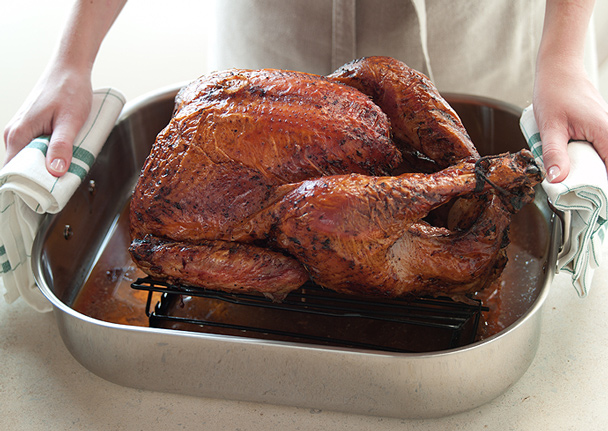Let's dispense with the regular turkey gobbledygook that permeates the media at this time of year and get down to basics: You've got a big, raw bird sitting in your fridge, a bunch of guests coming with holiday-high expectations in tow, and you need help. Sure, you may have heard all kinds of rules, lore, and even a few horror stories, but here's what you really need to know to successfully roast a turkey on Thanksgiving.
1. Consider Deconstructing Your Turkey
If presenting the traditional entire turkey on a platter is a significant part of your holiday ritual—and the meal unthinkable without it—then keep on doing it. But if moist breast meat and perfectly cooked dark meat is more important to you than that brief tabletop cameo of the whole bird, then take a tip from chefs, who've figured out how to produce serving after serving all day long on Thanksgiving: Roast your turkey in parts, the white meat separately from the dark meat. Buy just the parts you like, or, if you buy from a butcher, specify that you'd like your turkey broken down into breast, thigh, and drumstick pieces in advance. (Get the remaining parts from the butcher, too, for use in soup.)
Divide the white and dark parts into their own pans and roast on different racks, switching the position halfway through. This allows you to remove the breast when it's done and let the legs cook longer. The breast meat is moist at 165°F, but the dark meat is better when cooked to a minimum of 170°F, and as high as 185°F if you like yours well done, when the meat practically falls off the bones. For recipes for turkey cooked in parts, check out our Agave-Glazed Turkey Breast, Garlic-Chile Grilled Turkey Thighs, Chipotle Barbecue Pulled Turkey Drumstick Sliders, and Shredded Kale Salad with Turkey Cracklings.
2. Don't Wash the Turkey
This directive alone will probably shock you. And it holds true for chicken, too. Would you believe it comes directly from the super-cautious folks at the Food Safety and Inspection Service (FSIS), a division of the U. S. Department of Agriculture (USDA)? They've been advocating sparing your birds a bath for several years.
Here's why: The moment you run water on your poultry, you start spewing a mist of unwanted pathogens all over the sink and nearby items, such as your dish rack, where clean plates and flatware are probably air-drying. You probably think you are washing bacteria off the bird—but you aren't. Instead, the easiest and most effective way to eliminate bacteria is to kill them in the heat of the oven. So get that bird onto the rack in your roasting pan, and then dry it inside and out with paper towels. Or if you're brining your bird, put it directly into its salt bath (more on that next).
And don't forget to wash every surface the turkey or its juices might have touched. Use hot soapy water, and it doesn't hurt to follow up with disinfectant. When that's done, wash your hands well with warm soapy water. Pretend you're a surgeon prepping for an operation, and scrub both sides of your hands and under your nails.
3. Brining Is Strictly Optional
Brining the turkey was all the rage a while ago, and it still has a devoted following, particularly among those who have the space—preferably a second refrigerator—and a container large enough to immerse the turkey in a liquid brine. Fashions in brine recipes come and go, of course, but if you'd like to try brining, this basic formula will always do the job: For a 12- to 14-pound turkey, stir together 8 quarts water with 2 cups kosher salt in a 5-gallon bucket lined with a large heavy-duty plastic garbage bag and soak your raw turkey, covered and chilled, overnight (10 hours).



 Pinterest
Pinterest


